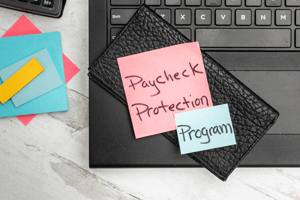 The American Institute for Certified Public Accountants (AICPA) recently issued a Technical Question and Answer (TQ&A) that provides guidance on accounting for loans issued under the Paycheck Protection Program (PPP).
The American Institute for Certified Public Accountants (AICPA) recently issued a Technical Question and Answer (TQ&A) that provides guidance on accounting for loans issued under the Paycheck Protection Program (PPP).
Entities may account for the PPP loan as a financial liability in accordance with FASB ASC 470, Debt, regardless of whether a nongovernmental entity expects to repay the loan or believes the loan is, in substance, a grant. If an entity chooses to account for the PPP loan as a financial liability, interest would be accrued under FASB ASC 835-30, Interest. However, an entity would not need to impute interest to the market rate as transactions prescribed by governmental agencies are excluded from the scope of FASB ASC 835-30. The financial liability would be extinguished (derecognized) when: (a) the loan is wholly or in part forgiven and the borrower has been legally released or (b) the borrower pays off the loan. Upon the financial liability being extinguished, an entity would record a gain on extinguishment in the income statement.
If a nongovernmental entity that is not a not-for-profit entity believes the loan is, in substance, a grant that will be forgiven, the entity may account for the PPP loan in accordance with IAS 20, Accounting for Government Grants and Disclosure of Government Assistance. Under IAS 20, government assistance is not recognized until there is reasonable assurance (probable threshold under U.S. Generally Accepted Accounting Principles) that: (a) any conditions attached to the government assistance will be met and (b) assistance will be received. Once there is reasonable assurance that the conditions will be met, the PPP loan is recorded as a cash inflow and deferred income liability. The liability would be offset through earnings as costs related to the loan are recognized.
If a nongovernmental entity that is not a not-for-profit entity, believes the loan is, in substance, a grant that will be forgiven, the TQ&A noted that the entity can follow the guidance in FASB ASC 958-605, Not-for-Profit Entities, or FASB ASC 450-30, Contingencies.
Under FASB ASC 958-605 model, the entity would account for the PPP loan as a conditional contribution and would record the cash inflow as a refundable advance and recognize the contribution once conditions have been substantially met or explicitly waived.
Under the FASB ASC 450-30 model, the PPP loan would be treated as a gain contingency. The PPP loan would be initially recorded as a cash inflow and as a financial liability. The financial liability would remain until the grant proceeds are realized or realizable.
Regardless of the method that is used, nongovernmental entities with material PPP loans should disclose the accounting policy and related impact to the financial statements.


